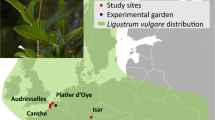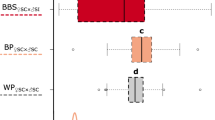Summary
Attempts were made to break the self-incompatibility in L. peruvianum by selection of mutated S-alleles through large-scale self-pollination on clones with pollen which was mutagenically treated in different stages of development. Besides self-compatibility was searched for in inbred lines.
The self-incompatibility in L. peruvianum was found to be very strict indeed. From more than 22,000 self-pollinations on 5 clones 1527 seeds were obtained, seed set being very erratic. The possible causes of this seed set are discussed. From 1527 seeds 1036 plants were raised and tested for self-compatibility.
In the progenies of 4 clones from 823 plants tested, 7 were more or less self-compatible. It is concluded that this self-compatibility was spontaneous and not the result of the mutagenic treatment.
In the progeny of the fifth clone plants were found which reacted as self-compatible at a temperature of about 40°C and as self-incompatible at lower temperatures. It is suggested that this character—a high temperature sensitive incompatibility reaction—is governed by one recessive gene.
In inbred lines plants were found with a stable form of self-compatibility and also plants with a high temperature sensitive incompatibility reaction.
The problems of an incompatibility research on inbred material are discussed. A brief survey is given of some of the characters found in inbred L. peruvianum.
Similar content being viewed by others
References
Arasu, N. T., 1968. Self-incompatibility in Angiosperms: a review. Genetica 39:1–24.
Atwood, S. S., 1942. Genetics of pseudo-self-compatibility and its relation to cross-incompatibility in Trifolium repens. J. agric. Res. 64:699–709.
Brewbaker, J. L. & Emery, G. C., 1962. Pollen radiobotany. Radiat. Bot. 1:101–154.
Brewbaker, J. L. & Natarajan, A. T., 1960. Centric fragments and pollen-part mutation of incompatibility alleles in Petunia. Genetics 45:699–704.
Brewbaker, J. L. & Shapiro, N., 1959. Homozygosity and S-gene mutation. Nature 183:1209–1210.
Davies, D. R. & Wall, E. T., 1961. Gamma radiation and interspecific incompatibility in plants. Effects of ionizing radiations on seeds, IAEA, Vienna:83–101.
Denward, T., 1963. The function of the incompatibility alleles in red clover (Trifolium pratense L.). Hereditas 49:189–236, 285–334.
East, E. M. & Mangelsdorf, A. J., 1925. A new interpretation of the hereditary behaviour of self-sterile plants. Proc. natn. Acad. Sci. 11:166–171.
Eyster, W. H., 1941. The induction of fertility in genetically self-sterile plants. Science 94:144–145.
Günther, E., Herrmann, H. & Hoffmann, M., 1968. Untersuchungen zur Selbstinkompatibilität von Lycopersicon peruvianum (L.) Mill. Biol. Zbl. 87:471–479.
Hoffmann, M., 1969. Induktion und Analyse von selbstkompatiblen Mutanten bei Lycopersicon peruvianum (L.) Mill. I. Induktion und Vererbung der Selbstfertilität. Biol. Zbl. 88:731–736.
Hogenboom, N. G., 1968. Self-compatibility in Lycopersicum peruvianum (L.) Mill. Euphytica 17:220–223.
Hogenboom, N. G., 1972. Breaking breeding barriers in Lycopersicon. 3. Inheritance of self-compatibility in L. peruvianum (L.) Mill. Euphytica 21:244–256.
Kendall, W. A. & Taylor, N. L., 1969. Effect of temperature on pseudo-self-compatibility in Trifolium pratense L. Theor. appl. Genet. 39:123–126.
Kho, Y. O. & Baër, J., 1968. Observing pollen tubes by means of fluorescence. Euphytica 17:298–302.
Lamm, R., 1950. Self-incompatibility in Lycopersicon peruvianum Mill. Hereditas 36:509–510.
Lamm, R., 1953. Observations on Lycopersicon peruvianum crosses. Tomato Genet. Coop. Rep. 3:14–15.
Leffel, R. C., 1963. Pseudo-self-compatibility and segregation of gametophytic self-incompatibility alleles in red clover, Trifolium pratense L. Crop Sci. 3:377–380.
Lewis, D., 1948. Structure of the incompatibility gene. I. Spontaneous mutation rate. Heredity 2:219–236.
Lewis, D., 1949. Structure of the incompatibility gene. II. Induced mutation rate. Heredity 3:339–355.
Lewis, D., 1951. Structure of the incompatibility gene. III. Types of spontaneous and induced mutation. Heredity 5:399–414.
Lewis, D., 1954. Comparative incompatibility in angiosperms and fungi. Adv. Genet. 6:235–285.
Lewis, D. & Crowe, L. K., 1953. Theory of revertible mutations. Nature 172:501.
Lewis, D. & Crowe, L. K., 1954. Structure of the incompatibility gene. IV. Types of mutations in Prunus avium L. Heredity 8:357–363.
Linskens, H. F. & Esser, K. L., 1957. Über eine spezifische Anfärbung der Pollenschläuche im Griffel und die Zahl der Kallosepfropfen nach Selbstung und Fremdung. Naturwissenschaften 1:16.
Linskens, H. F. & Kroh, M., 1967. Inkompatibilität der Phanerogamen. Handb. Pflphysiol. 18:506–530.
Lundqvist, A., 1961. Self-incompatibility in Festuca pratensis Huds. Hereditas 47:542–562.
Martin, F. W., 1961. The inheritance of self-incompatibility in hybrids of Lycopersicon esculentum Mill. x L. chilense Dun. Genetics 46:1443–1454.
Martin, F. W., 1963. Distribution and interrelationships of incompatibility barriers in the Lycopersicon hirsutum Humb. and Bonpl. complex. Evolution 17:519–528.
McGuire, D. C. & Rick, C. M., 1954. Self-incompatibility in species of Lycopersicon sect. Eriopersicon and hybrids with L. esculentum. Hilgardia 23:101–124.
Melton, B., 1970. Effect of clones, generation of inbreeding and years on self-fertility in alfalfa. Crop Sci. 10:497–500.
Nasrallah, M. E. & Wallace, D. H., 1968. The influence of modifier genes on the intensity and stability of self-incompatibility in cabbage. Euphytica 17:495–503.
Nettancourt, de, D., 1969. Radiation effects on the one locus-gametophytic system of self-incompatibility in higher plants (A review). Theor. appl. Genet. 39:187–196.
Nettancourt, de, D. & Ecochard, R., 1968. Effects of chronic irradiation upon a self-incompatible clone of Lycopersicum peruvianum. Theor. appl. Genet. 38:289–293.
Nettancourt, de, D. & Ecochard, R., 1969. New incompatibility specificities in the M3 progeny of a clonal population of L. peruvianum. Tomato Genet. Coop. Rep. 19:16–17.
Nettancourt, de, D., Ecochard, R., Perquin, M. D. G., Drift, T., van der & Westerhof, M., 1971. The generation of new S-alleles at the incompatibility locus of Lycopersicum peruvianum Mill. Theor. appl. Genet. 41:120–129.
Oehlkers, F., 1946. Weitere Versuche zur Mutationsauslösung durch Chemicalien. Biol. Zbl. 65:176–186.
Pandey, K. K., 1956. Mutations of self-incompatibility alleles in Trifolium pratense and T. repens. Genetics 41:327–343.
Pandey, K. K., 1959. Mutations of the self-incompatibility gene (S) and pseudo-compatibility in Angiosperms. Lloydia 22:222–234.
Pandey, K. K., 1965. Centric chromosome fragments and pollen-part mutation of the incompatibility gene in Nicotiana alata. Nature 206:792–795.
Pandey, K. K., 1967. Elements of the S-gene complex. II. Mutation and complementation at the SI locus in Nicotiana alata. Heredity 22:255–283.
Pandey, K. K., 1968. Colchicine-induced changes in the self-incompatibility behaviour of Nicotiana. Genetica 39:257–271.
Pandey, K. K., 1970a. New self-incompatibility alleles produced through inbreeding. Nature 227:689–690.
Pandey, K. K., 1970b. Time and site of the S-gene action, breeding systems and relationships in incompatibility. Euphytica 19:364–372.
Prell, H., 1921. Das Problem der Unbefruchtbarkeit. Naturw. Wschr. N.F. 20:440–446.
Rick, C. M., 1963. Barriers to interbreeding in Lycopersicon peruvianum. Evolution 17:216–232.
Rick, C. M. & Lamm, R., 1955. Biosystematic studies on the status of Lycopersicon chilense. Am. J. Bot. 42:663–675.
Rick, C. M. & Smith, P. G., 1953. Novel variation in tomato species hybrids. Am. Nat. 87:359–373.
Shapiro, N., 1966. Effects of X-rays on frequency of mutations in hydrated wild-type tomato pollen. Radiat. Bot. 6:337–350.
Townsend, C. E., 1966. Self-compatibility response to temperature and the inheritance of the response in tetraploid alsike clover, Trifolium hybridum L. Crop Sci. 6:409–414.
Townsend, C. E., 1968. Self-compatibility studies with diploid alsike clover, Trifolium hybridum L. III. Response to temperature. Crop Sci. 8:269–272.
Townsend, C. E., 1970. Inheritance of a self-compatibility response to temperature and the segregation of S-alleles in diploid alsike clover, Trifolium hybridum L. Crop Sci. 10:558–563.
Author information
Authors and Affiliations
Rights and permissions
About this article
Cite this article
Hogenboom, N.G. Breaking breeding barriers in Lycopersicon. 2. Breakdown of self-incompatibility in L. peruvianum (L.) Mill. . Euphytica 21, 228–243 (1972). https://doi.org/10.1007/BF00036763
Received:
Issue Date:
DOI: https://doi.org/10.1007/BF00036763




